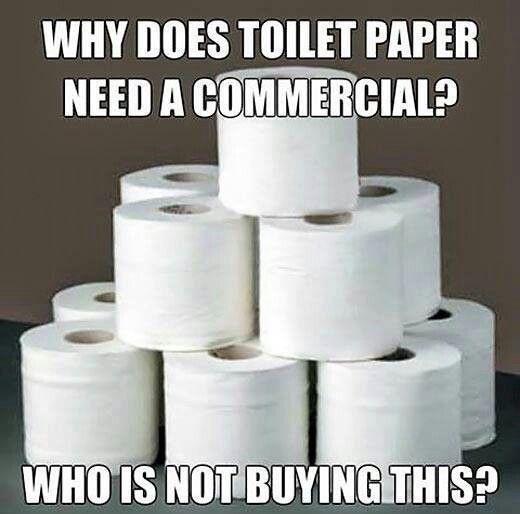Who Says Toilet Paper Sells Itself
I was looking at my Facebook account the other day - normally a waste of time, but a great source of reading material - and came across this picture:
[caption id="" align="alignnone" width="350"] Why does toilet paper need a commercial?[/caption]
Why does toilet paper need a commercial?[/caption]
My first reaction, like most, was to laugh. After all, everyone is buying toilet paper. You need to advertise iPads, so people will buy them instead of Kindles, laptops, or nothing at all, but who, in a modern, developed economy, will go without toilet paper?
Delving a little more deeply, though, one understands that you actually do need to advertise for toilet paper.
Let's start with the assumption that the marketing staff at Procter & Gamble, who make Charmin, are properly compensated, and are not out there wasting money on television, radio, Facebook and Google ads ("Don't Squeeze the Charmin!"). They must have a good reason for spending that money. What is it?
Advertising/commercials actually serve several distinct purposes. The above joke confuses them and ignores the other, perhaps more important ones:
- Product Awareness: This is critically important when you have a new product, either new to the industry or new to your company, and want to make customers aware of it. If we still lived in the days when people wiped themselves with stones or leaves, and you had this amazing new product called "toilet paper", then the purpose of advertising for toilet paper would be to make consumers aware that a much better alternative exists.
- Market Share: This is important when the products are generally known, but alternatives exist in the market. To return to our iPad example, just about everyone in the US knows about tablets, but they can choose an iPad, a Google Nexus, a Samsung Note, a Kindle Fire. Apple advertises its iPads to drive potential customers to buying an iPad over the alternatives.
- Increase Consumption: Even if you know of the product, and you prefer a particular brand, you can be induced to purchase more of it. If you already know about tablets, you even have an iPad, but were not considering one for your teenager in school. Commercials featuring iPads in a school setting can induce you to increase consumption.
In developed markets, absolutely everyone knows about toilet paper. P&G doesn't advertise Charmin for product awareness, since everyone knows it (hence the joke picture). Similarly, no one will increase consumption beyond what they would otherwise. People use the facilities as often as they do, cleanse themselves with toilet paper and are done. Unlike iPads or oranges, no one will buy more than they normally would.
But there is fierce competition among the brands. P&G wants you to really believe in the benefits of Charmin; Georgia-Pacific wants you to prefer Quilted-Northern. They are battling for your market share via commercials.
You always need to understand why you are advertising and for whom.
The joke image is almost correct. It just needs to end with: "Who is not buying this one?"